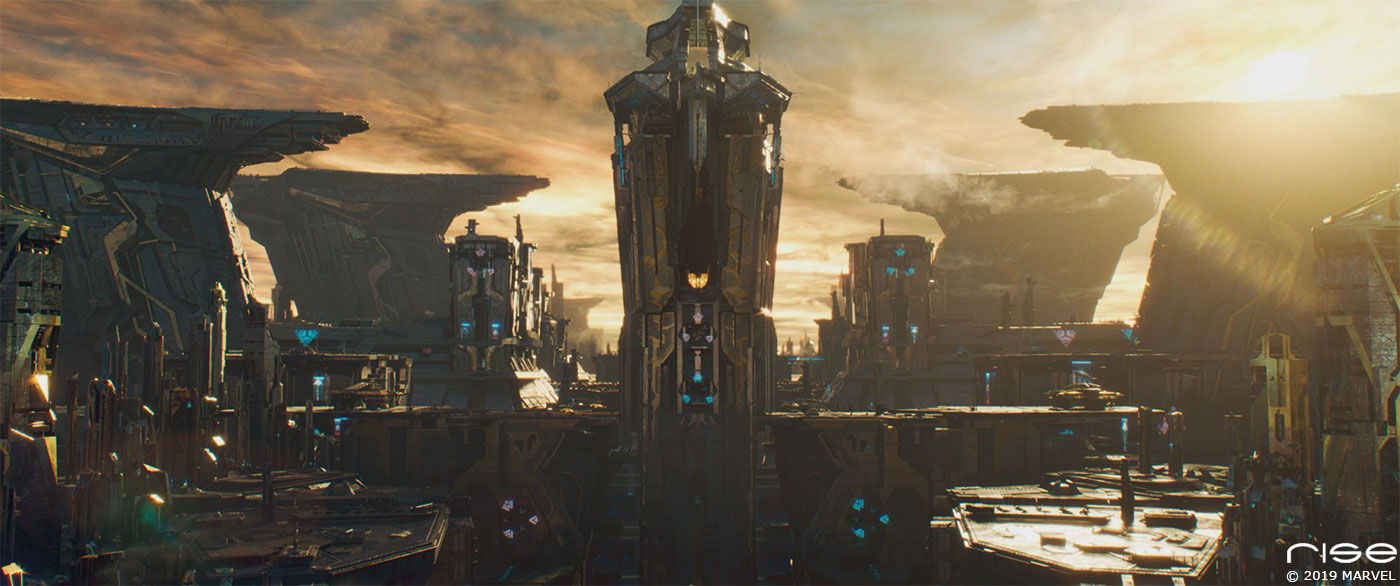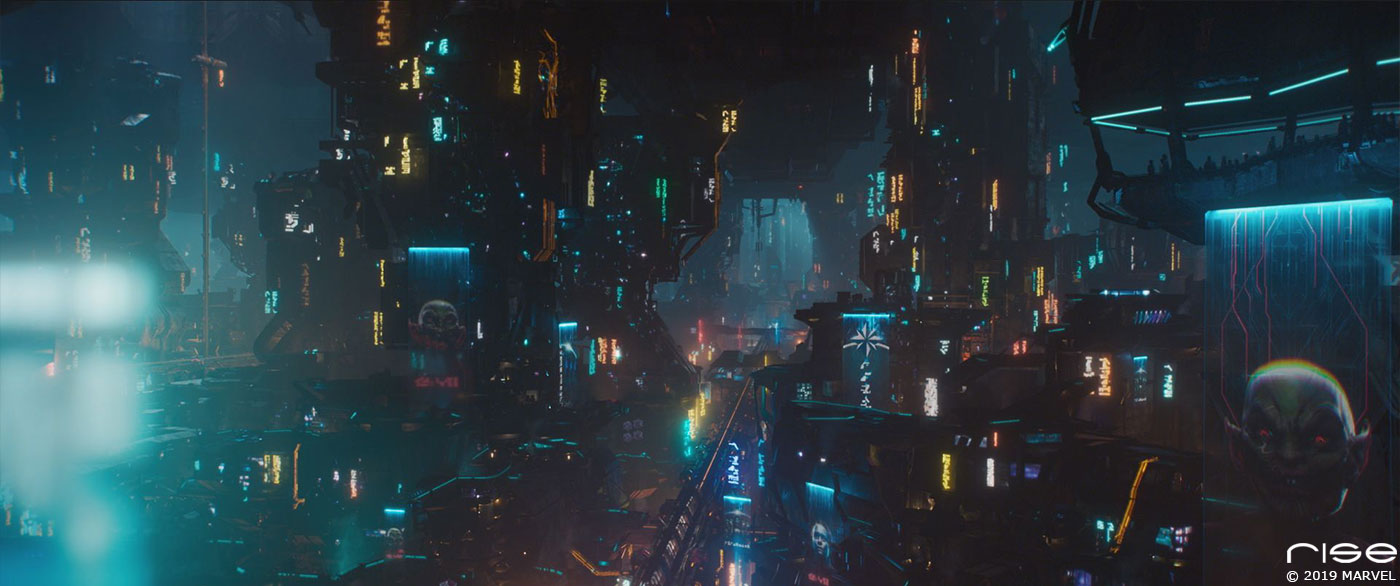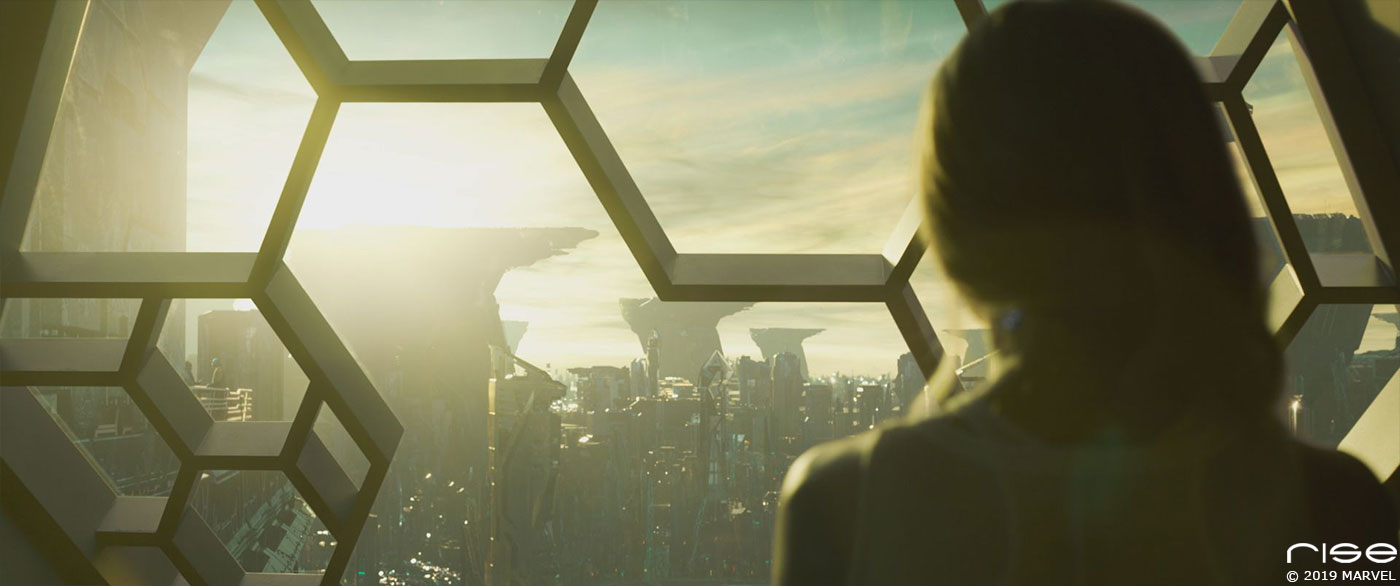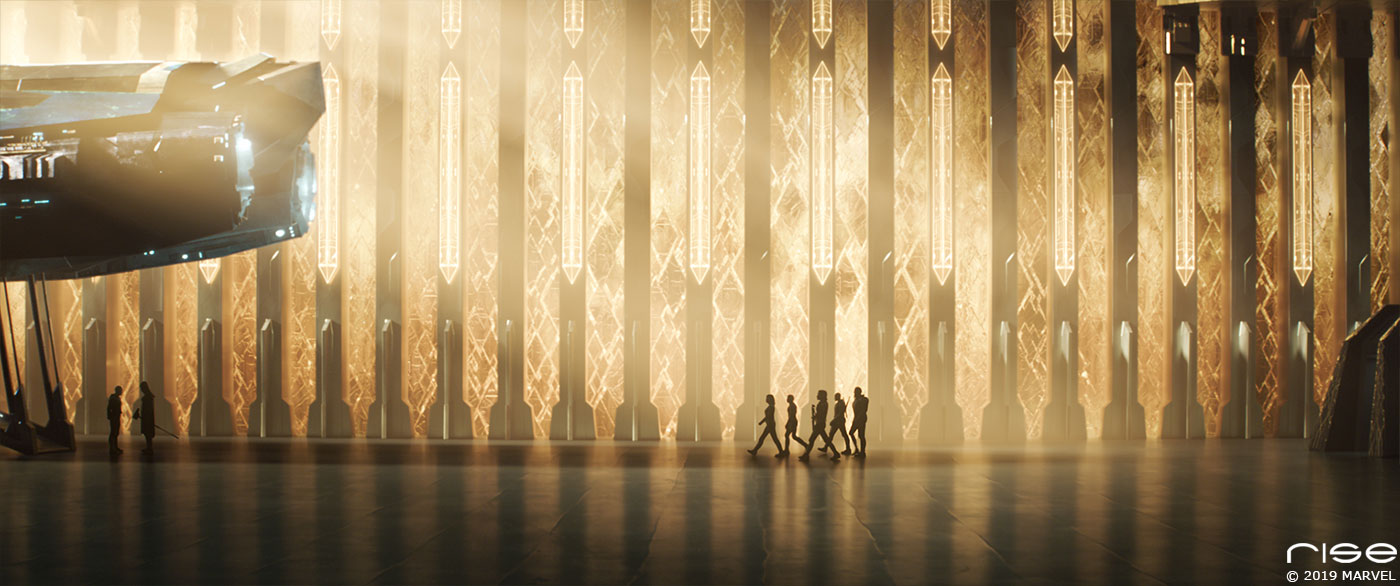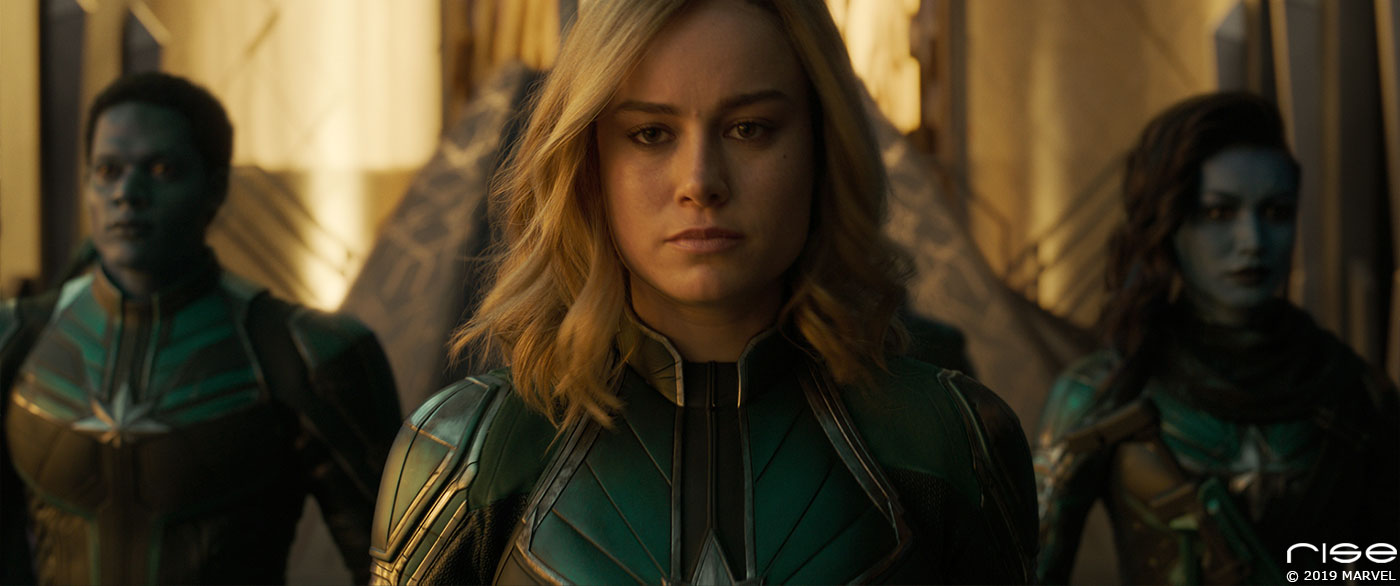Last year, Oliver Schulz explained the work of RISE on AVENGERS: INFINITY WAR. He talks to us today about CAPTAIN MARVEL.
How did you and RISE get involved on this show?
Our Executive Producer Florian Gellinger has been working with Christopher Townsend before and RISE has a long working relationship with Marvel so this made us a good fit on this project.
How was the collaboration with directors Anna Boden, Ryan Fleck and VFX Supervisor Christopher Townsend?
We had all of our communication in weekly cineSyncs with overall VFX Supervisor Christopher Townsend. It was always a pleasure to talk through all of the notes with him and his expertise in communicating the vision of the filmmakers to us made our job as straight forward as designing alien cityscapes can possibly be.
What was their expectations and approach about the visual effects?
They always wanted the VFX to be somewhat grounded in reality and to look as if they could have been shot on camera and not stand out as FX shots. The goal was to make everything look photographic.
How did you organize the work with your VFX Producer?
The VFX Producer on this show was Monique Pollaehne and she did a terrific job in keeping everything running smoothly. She always had an eye on delivery schedules, artist bookings, dailies and the communication with our Stuttgart office where lots of our shots were done. As we already know each other from previous projects where we worked together our working methods lined up pretty well.
What are the sequences made by RISE?
Our main responsibility was to create the alien city of Hala. There it can be divided into three main sequences. The first one is the sequence in Vers sleeping quarter which shows the upper City part of Hala. The second one is the train ride sequence in the lower part of Hala city and the third takes place in the big Dockingtower where Vers and Jon Rogg and the other StarForce members board their starship Helion.
How did you work with the art department to create the beautiful city on the Planet Hala?
We received a lot of conceptual artwork from Marvel’s Art department before starting our work on any of the assets. They had blocked the entire city out of basic geometries as a base for their own development. That was pretty handy to have as this provided a good starting point for us when continuing their work on developing the look and Layout of this enormous city. This also eliminated a lot of guesswork because we were able to find specific sections in this set that have been used in creating key concepts that production really liked and wanted us to incorporate when we started to layout the actual shots. Although some designs changed during the project to better fit the story or the mood, the initial conceptualization was always our starting point when creating Hala.
What was the real size of the sets?
As we had three main sequences we also had three main sets that production build and shot all plates in. The first one was the sleeping quarter which was build completely on set with just slight augmentation of VFX in the end. It just featured a greenscreen outside the windows where we placed upper Hala in the background.
The second set build was a sub Hala transport station together with one train segment that was build on rails so it could be driven into this station. The station needed to be extended into the distance and dressed with various Skrull warning holograms. The train segment was one main set where there’s a dialogue sequence between Vers and Jon Rogg. The train itself needed to be extended downwards when viewed from outside and we replaced all windows with thick glass and added automatic sliding doors with the accompanying mechanisms.
The third set build was a partially build of the Dockingtower interior which consisted of an entrance and columns placed on one side of the set. This was shot on a Soundstage and needed extensive augmentation or replacement in Post as most of the set lighting was placed between the columns and needed to be replaced with translucent self illuminating glass with a crystalline shimmering to it. Also the walls and ground of the docking Tower needed to be extended by several hundred meters to contribute to this gigantic cathedral feeling that this set had to it.
There actually was a fourth set build which was the interior of the Helion Spaceship that is located in the enormous hangar of the Dockingtower. This was fully build and just required either upper Hala or the Hangar to be inserted in Windshield and opening of the rear entrance. We also replaced the real entrance of the Helion Set with a digital version that could be closed in one shot. The main establishing Shots were mostly full CG.
Can you explain in detail about the creation of this city?
We divided the city in two main parts which is the lower part, a kind of underground city which is not as rich and glorious and the upper part that is build on top of this which features large and shiny sci-fi architecture as well as all the military building compounds like the grand docking Tower. We started to layout the city with two look-dev shots in upper and lower Hala. This was first mainly based on the art department layout. Then we went from there and layouted to make these shots look interesting and tried to tell as much about this city as possible in the screen time given. Both city parts underwent some major architectural look changes as we went on and probably lower Hala changed the most. We always made sure to stay true to shape languages already established to tie everything together.
We then quickly began to create procedural systems to generate second level detail like windows, platforms, machineries and other geometries to sell scale with indicating levels in these buildings. Otherwise this huge amount of geometry would never be able to render on any machine in our farm. This was spearheaded by our talented TD Dominik Pott who build these as tools in Houdini for our layout and lighting artists to use. He also created tools to scatter lights and neon signs. Regarding upper Hala there wasn’t that much industrial detail to the architecture as this was meant to be much more shiny, glorious and slick. We did create tools to scatter building tops and background buildings though to gave the city more variety.
When those procedures were in place we started to split work up into sequences with the train ride one being given to our Stuttgart office supervised on 3D side by Tonio Freitag where the team began to layout the whole journey through lower Hala. There, all backgrounds and parts of the train that needed to be exchanged were brought into place and rendered. They also took care of finishing the Dockingtower sequence and created a look for the shimmering and self illuminating glass walls. The finishing of this glass look was then being done by our Stuttgart compositing team supervised by Benjamin Burr who with his team composited most of the plate-based shots in this show.
The full CG establishing shots were done mostly in Berlin. CG Supervisor Alexander Schumann took care to get all assets into place for these enormous shots that in some cases rendered up to 70 hours per frame. All the compositing work was either done by my invaluable Comp Sup Oliver Hohn or supervised by him.
Can you tell us more about the shaders and texture work for the city?
When it came to texturing and shading all these assets we tried to make good use of in-house developed tools for procedural texturing together with a mixture of hand painted maps for hero buildings. We needed to use a lot of shared textures and procedural variation tools to not exceed the amount of RAM when rendering.
Here again there were two different methods for the two city parts. In lower Hala which is a lot more grungy and weathered we started our look-dev with oxidized aluminum materials but quickly landed on a look that was mostly concrete based with metal applications. To get the weathered concrete look we hand painted leak, edgewear and destruction maps in Mari and combined that with procedural base maps in our Houdini shading system to create the final look.
For upper Hala the building look was mostly based on shiny metals that have their own problems when it comes to lighting and rendering but as the look was much cleaner it was easier to create procedural texturing there as it was in lower Hala. We did use a lot of color, roughness and anisotropy variance through asset IDs and other geometry attributes to vary the look of different buildings. Again here as well we did hand paint lots of textures for hero buildings like the grand docking Tower.
How did you populated it with transports and people?
The production shot lots of elements of extras that were keyed and used either as hand placed elements or as a sprite system in compositing. When it comes to transport or traffic in Hala it was a mixture of our Houdini crowd based system for most of the background traffic. All of the foreground action was hero keyframe animation as they needed precise timing and positioning.
Can you tell us more about the creation of the various spaceships?
As most of the spaceships are shared assets like the StarForce Helion ship or the Kree Accuser ships, we got them delivered by other vendors that had already built them and just ingested and lookdeved them to match their reference. All none hero spaceships that we needed to populate our city were designed and modelled at RISE by our talented asset team to match the shape language already established in the Hero ships.
The city is really massive. How does that affects your lighting work?
The lighting and rendering of these shots indeed proved some challenges. First the underground city is at its core an indoor environment because it’s got a ceiling with openings here and there where the sky lighting peaks through. This created shafts of light which again were also used as a compositional element to silhouette buildings and structures to make this city more readable. To sum this up we got an indoor environment together with hundreds of lights, neon signs, lit windows and to sell the depth and get the shafts of light we needed volumetric fog. These all are ingredients for a rendering nightmare so we tackled this problem really early on and again our TD Dominik was able to create some automation tools to incorporate Houdini’s GI lighting into our pipeline. Without those procedures this environment would not have been renderable.
The upper Hala shots had there own difficulties when it came to lighting and rendering. First of all the upper City itself was mostly based on metallic materials. This in combination with a harsh sun inherited difficulties in the overall coloring of shots because the bounce light of the sun would get reflected into shadows thus creating very monochromatic lighting. There was a lot of trickery involved in shading and comp to get the color variation into the city that was favored by production. The sheer amount of geometry in those shots itself together with the lighting led to some long render times, but in combination with really small and highly reflective geometries it quickly became really long. So in itself it was quite a task to get especially the full CG shots optimized and rendered. Luckily I had some very talented and patient lighting artists on board that overcame any hurdles.
Which sequence or shot was the most challenging?
Each sequence had their own challenge but overall I would say that the big full CG establishing shots were the most complicated to produce.
Is there something specific that gives you some really short nights?
I’m doing this for too long now to have sleepless nights but the pressure in the end to get all images out of rendering without any errors was definitely there!
What is your favorite shot or sequence?
There are really nice shots sprinkled all over the sequences but I think in the end the establishing shots of lower and upper Hala made me really proud on what the team has accomplished.
What is your best memory on this show?
Again I can say the teamwork that we had even on long nights or weekends and still being able to laugh makes my best memories.
How long have you worked on this show?
A little more than 11 months.
What’s the VFX shots count?
The shot count was around 60, but as I haven’t seen the film yet I’m not sure how many made it into the final cut.
What was the size of your team?
The team also was around 60 people in total.
What is your next project?
I don’t know yet as I’m on vacation right now 😉
A big thanks for your time.
WANT TO KNOW MORE?
RISE: Dedicated page about CAPTAIN MARVEL on RISE website.
© Vincent Frei – The Art of VFX – 2019


